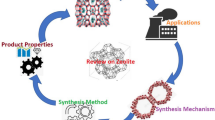Abstract
A new route including precipitation combined with calcination has been developed for the synthesis of strontium orthosilicate (Sr2SiO4) nano-sized particles. The stirring of the boiling aqua suspension prepared from hydrosilicagel derived from serpentine minerals ((Mg(Fe))6[Si4O10](OH)8), sodium hydroxide (NaOH) and strontium chloride (SrCl2) results in the precipitation of hydrated strontium silicate species whose dehydration is followed by their crystallization into strontium ortho- and metasilicate SrSiO3 on heating. The stirring time and sodium hydroxide concentration are the key parameters controlling strontium silicates formation. The influence of these parameters on the precipitates formation and their phase transformations at various temperatures has been studied by X-ray diffraction, thermal analyses and electron microscopy. The optimal parameters, namely the molar ratio of initial reagents, stirring time, the temperature and duration of heat treatment providing strontium orthosilicate synthesis, have been suggested. The average particle size of strontium orthosilicate synthesized by this method is 20–40 nm.











Similar content being viewed by others

Notes
Serpentinite is a rock largely composed of serpentine group minerals (Mg(Fe))6[Si4O10](OH)8.
References
Barry TL. Fluorescence of Eu2+-activated phases in binary alkaline earth orthosilicate systems. J Electrochem Soc. 1968;115(11):1181–4. https://doi.org/10.1149/1.2410935.
Shrivastava NK, Bapat MN, Khan M, Sivaraman S. Thermoluminescence and isothermal decay of Sr2SiO4:Dy. J Mater Sci. 1986;21(7):2540–6. https://doi.org/10.1007/bf01114304.
Yang J, Zuo Y, Liu H, Su W. The luminescence characteristics of europium activated strontium silicate synthesized at high temperature and high pressure. J Mater Sci Lett. 1996;15(21):1891–4. https://doi.org/10.1007/bf00264088.
Park JK, Lim MA, Kim CH, Park HD, Park JT, Choi SY. White light-emitting diodes of GaN-based Sr2SiO4: Eu and the luminescent properties. Appl Phys Lett. 2003;82(5):683–5. https://doi.org/10.1063/1.1544055.
Barzowska J, Chruścińska A, Przegiętka K, Szczodrowski K. Dosimetric features of strontium orthosilicate (Sr2SiO4) doped with Eu 2+. Radiat Phys Chem. 2014;104:31–5. https://doi.org/10.1016/j.radphyschem.2014.05.043.
Lee JH, Kim YJ. Photoluminescent properties of Sr2SiO4:Eu2+ phosphors prepared by solid-state reaction method. Mater Sci Eng B. 2008;146(1):99–102. https://doi.org/10.1016/j.mseb.2007.07.052.
He H, Fu R, Zhang X, Song X, Zhao X, Pan Z. Photoluminescence spectra tuning of Eu2+ activated orthosilicate phosphors used for white light emitting diodes. J Mater Sci Mater Electron. 2009;20(5):433–8. https://doi.org/10.1007/s10854-008-9747-5.
Hu Y, Zhuang W, Hao J, Huang X, He H. Preparation mechanism and luminescence of Sr2SiO4: Eu phosphor from (Sr, Eu) CO3@ SiO2 core-shell precursor. Open J Inorg Chem. 2012;2(1):6. https://doi.org/10.4236/ojic.2012.21002.
Chang Y-L, Hsiang H-I, Lan F-T, Mei L-T, Yen F-S. Synthesis of Sr2SiO4 nanometer particles from the core–shell precursor of SrCO3/SiO2. J Alloys Compd. 2010;500(1):108–12. https://doi.org/10.1016/j.jallcom.2010.04.002.
Guo H, Wang X, Zhang X, Tang Y, Chen L, Ma C. Effect of NH4F flux on structural and luminescent properties of Sr2SiO4: Eu2+ phosphors prepared by solid-state reaction method. J Electrochem Soc. 2010;157(8):J310–4. https://doi.org/10.1149/1.3454723.
Hsu C-H, Jagannathan R, Lu C-H. Luminescent enhancement with tunable emission in Sr2SiO4: Eu2+ phosphors for white LEDs. Mater Sci Eng B. 2010;167(3):137–41. https://doi.org/10.1016/j.mseb.2010.01.045.
Sahu IP. Orange-red emitting europium doped strontium ortho-silicate phosphor prepared by a solid state reaction method. Luminescence. 2017;32(3):364–74. https://doi.org/10.1002/bio.3188.
Chen H-Y, Weng M-H, Chang S-J, Yang R-Y. Preparation of Sr2SiO4:Eu3+ phosphors by microwave-assisted sintering and their luminescent properties. Ceram Int. 2012;38(1):125–30. https://doi.org/10.1016/j.ceramint.2011.06.044.
Hsu W-H, Sheng M-H, Tsai M-S. Preparation of Eu-activated strontium orthosilicate (Sr1.95SiO4:Eu0.05) phosphor by a sol–gel method and its luminescent properties. J Alloys Compd. 2009;467(1):491–5. https://doi.org/10.1016/j.jallcom.2007.12.014.
Kamei S, Kojima Y, Nishimiya N. Preparation and fluorescence properties of novel red-emitting Eu3+-activated amorphous alkaline earth silicate phosphors. J Lumin. 2010;130(11):2247–50. https://doi.org/10.1016/j.jlumin.2010.06.028.
Dutczak D, Milbrat A, Katelnikovas A, Meijerink A, Ronda C, Jüstel T. Yellow persistent luminescence of Sr2SiO4:Eu2+, Dy3+. J Lumin. 2012;132(9):2398–403. https://doi.org/10.1016/j.jlumin.2012.03.055.
Gupta SK, Mohapatra M, Kaity S, Natarajan V, Godbole SV. Structure and site selective luminescence of sol–gel derived Eu:Sr2SiO4. J Lumin. 2012;132(6):1329–38. https://doi.org/10.1016/j.jlumin.2012.01.011.
Wu Y, Wang Y, He D, Fu M, Zhao Y, Li Y, et al. Synthesis and luminescence properties of Sr2SiO4: Eu3+, Dy3+ phosphors by the sol–gel method. J Nanosci Nanotechnol. 2011;11(11):9439–44. https://doi.org/10.1166/jnn.2011.5217.
Gupta SK, Bhide MK, Kadam RM, Natarajan V, Godbole SV. Nanorods of white light emitting Sr2SiO4:Eu2+: microemulsion-based synthesis, EPR, photoluminescence, and thermoluminescence studies. J Exp Nanosci. 2015;10(8):610–21. https://doi.org/10.1080/17458080.2013.858833.
Gupta SK, Nigam S, Yadav AK, Mohapatra M, Jha SN, Majumder C, et al. An insight into local environment of lanthanide ions in Sr2SiO4: Ln (Ln = Sm, Eu and Dy). N J Chem. 2015;39(8):6531–9. https://doi.org/10.1039/C5NJ01191D.
Gupta SK, Pathak N, Thulasidas SK, Natarajan V. Local site symmetry of Sm3+ in sol–gel derived α′-Sr2SiO4: probed by emission and fluorescence lifetime spectroscopy. J Lumin. 2016;169:669–73. https://doi.org/10.1016/j.jlumin.2014.10.009.
Pan H, Li X, Zhang J, Guan L, Su H, Yang Z, et al. Crystal structure and luminescent properties of Sr2SiO4:Eu2+ phosphor prepared by sol–gel method. J Appl Biomater Funct Mater. 2016;14:62–7. https://doi.org/10.5301/jabfm.5000316.
Tang J-Y, Zhong H, Hao L-Y, Xu X. Synthesis of the uniform hollow spherical Sr2SiO4:Eu2+ phosphors via an h-BN protective method. Opt Mater. 2013;35(12):2618–23. https://doi.org/10.1016/j.optmat.2013.07.032.
Prathibha BS, Chandrashekara MS, Naghabhushan BM, Nagabhushan H. Photo and thermo luminescence studies of Sr2SiO4: Eu3+ phosphor. Int J Innov Eng Technol. 2015;6(2):190–200.
Verma D, Patel R. Low temperature solution combustion synthesis and luminescence properties of nanoparticle of Sr2SiO4: Dy 3 phosphors. Adv Appl Sci Res. 2015;6(6):89–94.
Venkataravanappa M, Nagabhushana H, Daruka Prasad B, Darshan GP, Basavaraj RB, Vijayakumar GR. Dual color emitting Eu doped strontium orthosilicate phosphors synthesized by bio-template assisted ultrasound for solid state lightning and display applications. Ultrason Sonochem. 2017;34:803–20. https://doi.org/10.1016/j.ultsonch.2016.07.004.
Zulumyan NO, Isaakyan AR, Oganesyan ZG. A new promising method for processing of serpentinites. Russ J Appl Chem. 2007;80(6):1020–2. https://doi.org/10.1134/s1070427207060353.
Zulumyan N, Mirgorodski A, Isahakyan A, Beglaryan H. The mechanism of decomposition of serpentines from peridotites on heating. J Therm Anal Calorim. 2014;115(2):1003–12. https://doi.org/10.1007/s10973-013-3483-7.
Zulumyan N, Isahakyan A, Beglaryan H, Melikyan S. A study of thermal decomposition of antigorite from dunite and lizardite from peridotite. J Therm Anal Calorim. 2018;131(2):1201–11. https://doi.org/10.1007/s10973-017-6705-6.
Zulumyan NO, Isaakyan AR, Pirumyan PA, Beglaryan AA. The structural characteristics of amorphous silicas. Russ J Phys Chem A. 2010;84(4):700–2. https://doi.org/10.1134/S003602441004031X.
Isahakyan AR, Beglaryan HA, Pirumyan PA, Papakhchyan LR, Zulumyan NH. An IR spectroscopic study of amorphous silicas. Russ J Phys Chem A. 2011;85(1):72–5. https://doi.org/10.1134/S0036024410121015.
Carlson ET, Wells LS. Hydrothermal preparation of some strontium silicates. J Res Natl Bureau Stand. 1953;51(2):73–80.
Felmy AR, Mason MJ, Gassman PL, McCready DE. The formation of Sr silicates at low temperature and the solubility product of tobermorite-like Sr5Si6O16(OH)2 5H2O. Am Mineral. 2003;88(1):73. https://doi.org/10.2138/am-2003-0109.
Osamu Y, Yoshifumi I, Kiyoshi S. Formation of Sr2SiO4 and SrSiO3 from strontium silicate hydrate prepared by the alkoxy method. Bull Chem Soc Jpn. 1980;53(1):275–6. https://doi.org/10.1246/bcsj.53.275.
Kirschenbaum H. The classical chemical analysis of silicate rocks: the old and the new. Washington, U.S. Geological survey bulletin 1547;1983.
Langford JI, Wilson AJC. Scherrer after sixty years: a survey and some new results in the determination of crystallite size. J Appl Crystallogr. 1978;11(2):102–13. https://doi.org/10.1107/S0021889878012844.
Ropp RC. Group 14 (C, Si, Ge, Sn, and Pb) alkaline earth compounds. In: Ropp RC, editor. Encyclopedia of the alkaline earth compounds. Amsterdam: Elsevier; 2013. p. 351–480.
Acknowledgements
This work was supported by the RA MES State Committee of Science, in the frames of the research Project No. 16YR-1D025.
Author information
Authors and Affiliations
Corresponding author
Additional information
Publisher's Note
Springer Nature remains neutral with regard to jurisdictional claims in published maps and institutional affiliations.
Rights and permissions
About this article
Cite this article
Zulumyan, N., Isahakyan, A., Beglaryan, H. et al. The development of a new route to the synthesis of strontium orthosilicate. J Therm Anal Calorim 137, 1471–1481 (2019). https://doi.org/10.1007/s10973-019-08035-9
Received:
Accepted:
Published:
Issue Date:
DOI: https://doi.org/10.1007/s10973-019-08035-9



